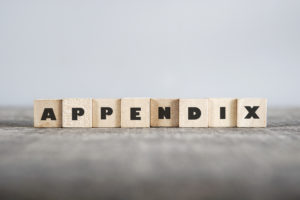What is an Appendix Page in a Book?
 You already know that a book’s back matter includes the epilogue and afterword (or postscript), but did you know it also includes an appendix page? An appendix page is a section located at the back of a book that includes any additional or supplementary information on the book’s topic, such as other books on the subject, references, citations, etc.
You already know that a book’s back matter includes the epilogue and afterword (or postscript), but did you know it also includes an appendix page? An appendix page is a section located at the back of a book that includes any additional or supplementary information on the book’s topic, such as other books on the subject, references, citations, etc.
Not every book has an appendix page – just like not every book has an epilogue or an afterword. Some books don’t warrant the need for an appendix. If a book has one, it’s there for a good reason.
What Kind of Books Use Appendices?
As appendices are used to bolster research, provide credibility, and list further references, they’re used (more often) in nonfiction books. Biographies (books about a person’s life written by someone else), autobiographies or memoirs (books about a person’s life written by that person), research-based books (medical textbooks, historical books), and cultural critiques are just a few nonfiction books that benefit from the presence of an appendix.
Why Include a Book Appendix Page?
There are several different reasons an author may include a book appendix.
To Provide Additional Information on a Topic
The book appendix is the perfect place for more details on a subject in the book that perhaps the author didn’t have time to include fully or didn’t have room for. The appendix may provide additional resources (books, articles, research) for the reader to explore on their own time.
To Cite Sources/Data
If the book is heavily research-based, the author may choose to include this back portion to list the sources they drew from to write the book. For example, if an author is writing about the life of Marie Curie, they may feel inclined to list out all the books and sources they utilized in the writing process.
Including an appendix can help build credibility. If an author lists out the materials they encountered in their research, it’s a sort of proof that they know what they’re talking about.
If the book is scientific or medical, the appendix can include data – graphs, charts, statistics, etc.
To Supply Original Materials
In biographies or memoirs, authors can include original materials such as letters, personal documents, photographs, emails, lists, etc. to add to the richness of their story.
How the Self-Publisher Can Include an Appendix Page
If you’re writing a nonfiction book that includes research on a particular topic, you should definitely include an appendix in your book’s back matter. Think back to when you were in school and had to include a “Sources Cited” or “Bibliography” page. This is a lot like that!
How the appendix is formatted will depend what types of materials or information you’re including in it. Look to some of your favorite books on your shelves for examples.
Appendix Page Examples
- In his cultural critique of how media and societal thought interact, Neil Postman includes a notes section, a bibliography, and an index in the back matter of Amusing Ourselves to Death.
- In The Inklings, a historical account of the Inklings of Oxford (C.S. Lewis, J.R.R. Tolkien, Charles Williams), Humphrey Carpenter includes several appendices. The first appendix includes additional biographical information on the people featured in the book. These details are saved for the appendix section rather than bog down the story. The second appendix is the bibliography – a list of all the books referenced in the story and used for researching the famous authors. The third appendix lists sources for the quotations used throughout the story – again, rather than bog down the body text. The last appendix serves as an acknowledgement page.
- In Leslie Jamison’s collection of essays, The Empathy Exams, a list of ‘Works Consulted’ includes books, other essays, articles, musical and dramatic works, and women consulted for the writing of her essays.
In each of these books, the appendices look different, and that’s because it comes down to how the author wants to present the information. In the writing of your book, you’ll find that a certain format works better than another. Above all else, you should focus on creating a book appendix page that is easy to understand and neatly presents additional resources for your readers to discover.
